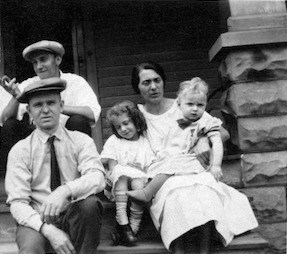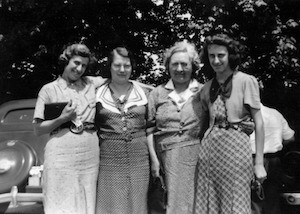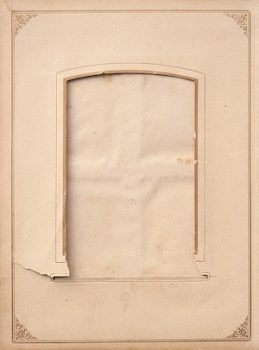by Mary Hrovat
 I was struck by a sentence in Susan Orlean’s The Library Book: “If nothing lasts, nothing matters.” This line was part of a discussion of memory, the fear of being forgotten, and the value of passing things on to future generations. I share a passion for the idea of continuity between generations (and I highly recommend Orlean’s book), but ultimately I don’t think that something has to last to matter. Alan Watts, in his book This Is It, says that “This—the immediate, everyday, and present experience—is IT, the entire and ultimate point for the existence of a universe.” It’s not about connecting with anything but what’s here in front of me now. (Easier said than done, of course.)
I was struck by a sentence in Susan Orlean’s The Library Book: “If nothing lasts, nothing matters.” This line was part of a discussion of memory, the fear of being forgotten, and the value of passing things on to future generations. I share a passion for the idea of continuity between generations (and I highly recommend Orlean’s book), but ultimately I don’t think that something has to last to matter. Alan Watts, in his book This Is It, says that “This—the immediate, everyday, and present experience—is IT, the entire and ultimate point for the existence of a universe.” It’s not about connecting with anything but what’s here in front of me now. (Easier said than done, of course.)
The idea that impermanence can be embraced is both a difficult one for me and something I sorely need. When I was in my early 20s, I rejected my parents’ religion, including its teachings about an afterlife. One of the longest-lasting effects of having once believed in an immortal soul has been the persistent sense that this brief existence, limited to 70 or 80 years on this planet if you’re lucky, can’t be as worthwhile or meaningful as a life that endures forever. On the other hand, being out from under the disapproving gaze of a punitive god and outside the limiting story of sin and redemption has ultimately been tremendously freeing.
###
I’ve tried, over the years, to replace the concept of an eternal spiritual realm and personal immortality with other forms of continuity. Today I am particularly grateful for the continuity of things outside of human life: Earth and its ecosystems (as badly as we’re damaging them, I think life will continue on Earth after we’re gone), the other planets in the solar system, and the universe as a whole. The awareness of something vast and powerful going on outside of our fates and in fact indifferent to them can be very comforting.
I love the continuity provided by books, and I don’t know who I’d be without the connections to other people that are mediated by books. These are fairly impersonal connections, though, and I hope that the possibility of sparking ideas in the minds of strangers was not the only source of meaning for the writers I read.
Family history is a more immediate and intimate source of connection, although my family’s story has always seemed truncated to me. My parents left their home town shortly after they married, and my siblings and I had only limited contact with the people they left behind. I have six cousins that I wouldn’t recognize if I saw them on the street, for example. I knew only one of my grandparents well, my mother’s mother, who lived with us while I was growing up. Every time Mom or Granny got a letter from someone back home, they’d talk over the latest news. I came to recognize some of the names that appeared frequently in their conversations, but I never met most of these people, and I didn’t understand how they were related to me. I knew very little of my father’s childhood or family. We had visits from various of my parents’ aunts and uncles, but except for one trip my father and I made when I was very small, none of us went back to visit family.
In addition, three of my grandparents were born in Europe and came to this country as children, so there was an additional disconnect a couple of generations back. I moved away from my family as a young adult, and then my siblings and I all left our parents’ church, so there’s something of a disconnect in my generation as well.
###
For years I thought that someday I’d hunt down the details of my family’s past and assemble a family history. I took to heart Charles Baxter’s words: “To remember is to triumph over loss and death; to forget is to form a partnership with oblivion.” I wanted my generation of our family to have a written history that went back at least a generation or two before my parents. I assumed without thinking about it that someone who came after me would preserve my story as I wanted to preserve those of my immediate forebears.
When I was in my late 30s, my parents began to provide some of the missing pieces of family history. A year or so before my mother died, she sent my siblings and me an essay about some of her memories of her childhood, along with photocopies of old photographs I wasn’t familiar with. I finally learned a bit about the people behind those names I remembered from her discussions with my grandmother. She was going to write a second installment about her young adulthood, but she died before she could do it. Mom also told me, shortly before she died, that she had found a diary that Granny had kept in 1941 when Mom’s father was building a house for his young family. She said she would send me a copy, but the diary was apparently lost or discarded at some point after she was gone.
 After Mom died, my father sent me an envelope full of photographs of her family. I hadn’t seen most of them before, and I was thrilled to have them. There were a few studio portraits, but most were black-and-white snapshots printed on thick paper, I would guess from the 1920s through the 1940s. Rather dauntingly, they were sparsely labeled, with very few names and no dates. However, I thought I might be able to identify some of the people from my mother’s essay and the photocopies she had included.
After Mom died, my father sent me an envelope full of photographs of her family. I hadn’t seen most of them before, and I was thrilled to have them. There were a few studio portraits, but most were black-and-white snapshots printed on thick paper, I would guess from the 1920s through the 1940s. Rather dauntingly, they were sparsely labeled, with very few names and no dates. However, I thought I might be able to identify some of the people from my mother’s essay and the photocopies she had included.
Around the time my father sent me those photos, he also started emailing stories about his early life, which had been until then almost entirely a closed book, to me and my siblings. After my father died, in 2016, one of my brothers sent me old photos Dad had saved, most of which were new to me, and which I was also delighted to have. My father had written his memories in no particular order; I decided to organize his stories as best I could and scan a few of the photos—a grade school picture taken when my father wasn’t much older than my grandsons are now, his high school graduation picture, one or two photos of my parents on their honeymoon—to add to the stories. I sent copies of the resulting PDF file to my siblings.
###
Recently, though, I’ve started to see all of this activity less as a vital connection to the past or the future, and more as something I do for the pleasure of it.
For one thing, even on a very small and intimate scale, history is inaccurate. When my father died, I wrote his obituary, in consultation with my siblings. A year or so after that, when I was going through my father’s old email messages, I realized that I’d made a mistake; I’d misidentified the city that my father did volunteer work for during his retirement. It’s a tiny thing, and I wish I’d caught it at the time, but I doubt that mistakes like that are unique in the annals of the obituary.
When I put together the PDF with my father’s stories and the photographs, my siblings thanked me, but I got the impression that it didn’t carry the same weight for them as it did for me. I had envisioned the information being shared with Dad’s grandchildren and eventually his great-grandchildren, but maybe not. This is not a complaint. It was satisfying to put that information together, and it’s good to know that it’s not an obligation or an expectation—just something I did because I wanted to.
Seventeen years after receiving my grandmother’s photographs, I still haven’t made any serious effort to identify the people in them. One reason is that even if I could put names to some of the faces, I still wouldn’t know the stories behind the photos. What occasion brought these people together? Did they dance when this man played the accordion he’s holding? Whose wagon full of hay was this, whose house?

Another reason is that I don’t know who would want the photos after I’m gone, even if I labeled them as well as I could. A few of them have notes on the back—mostly opaque to me, evidently little in-jokes among my grandmother and her family and friends when she was a young woman. I would guess the photos were passed around the family, where everyone already knew who everyone was. If anyone at the time had been thinking seriously about posterity, it seems like they would have annotated those photos with things other than “oo la la” and “who boss? same here.” Maybe I’ll decide that the puzzle of figuring out what I can is worth the effort; maybe I’ll decide to leave the unknowable past to the people who lived it.
I still wish I had my grandmother’s diary. I would like to see what Granny wrote as she watched her husband building that house for her and their children. It would also be lovely to hold the diary in my hands. Old things like that have a lot of power for me. However, I no longer feel like this is a missing piece of a saga I need to construct. I may be the only one who wants to read it, and it probably wouldn’t have looked like a precious relic to whoever cleans up after me when I’m gone.
###
Another treasure that came to me after my father died was a magazine for brides from the late 1950s, which presumably my mother consulted as she planned their wedding. The ads alone are a source of considerable fascination. One ad urges brides to “keep forever the wedding day loveliness of your cherished bridal gown.” Through something called the Le Boeuf process, a wedding dress could be cleaned and then sealed into a “fully transparent case” (plastic, I assume) so that it’s “preserved forever in a golden treasure chest.” Because I didn’t see this until I was in my 50s, all I could imagine was middle-aged offspring wondering what to do with these things. The wedding dress might still be considered a keepsake, but what about that golden treasure chest? (For the record, my mother’s wedding dress is in a suitcase in my brother’s garage, having reposed for decades in a cardboard dress box in various closets. I’ve offered to take it if it can be shipped without falling apart.)
The wedding dress is an example of a certain class of objects that the dead leave behind, things that have sufficient emotional power that the living are reluctant to discard them, but that are not necessarily things anyone knows what to do with. I enjoy being a repository for such things that belonged to my parents and grandparents, and in fact I might welcome things that others could throw away without a qualm. However, I suspect that the power weakens with distance in time, and my sons will probably have no trouble discarding much of what I’ve saved. Wedding dress caskets notwithstanding, I think that’s how it’s supposed to work.
###
Although I’ve told my sons a good bit about my childhood and young adulthood, their mental images of it are ultimately going to be as imprecise and incomplete as my memories of my parents’ early lives. My sons will remember me as their mother; my grandsons are going to remember me as who I am now. And their memories of that, even if they live long lives, really won’t travel all that far into the future. As Marcus Aurelius put it: “All of us are creatures of a day; the rememberer and the remembered alike.”
I no longer see my accumulation and gathering and curating (to the extent that I do it) as something essential, a record that must be kept in a fight against oblivion. It’s a game I’m playing because I enjoy it. To paraphrase Carl Sandburg in his poem “Stars, Songs, Faces,” I’m gathering the photos and words because I wish it so. Overall, I’m okay with the fact that much has been and will be forgotten and misremembered. As a result, I feel lighter as I move into the future. Although I hope I have a long time yet to live, I’m more ready now than I used to be to follow Sandburg’s advice when I come to die: “Let the faces and years go. Loosen your hands and say goodbye.”
###
Last image courtesy of Pixabay. You can see more of my work at maryhrovat.com.
